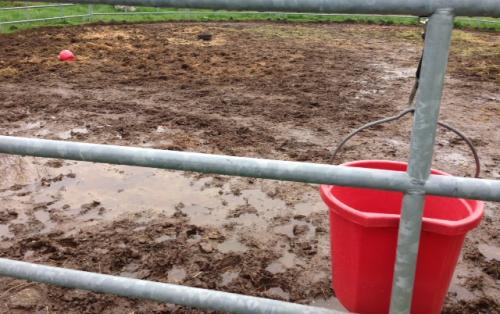Mud, mud go away- leave me and my horses alone: Part 1
Identifying the factors that are contributing to the creation and occurrence of mud on your horse farm may require some “out of the box” thinking and management.

It is that time of year; spring is here, so bring on the mud…or not. If you are a caretaker of horses you will be more than likely dealing with mud. It is well known why mud can become a problem for horses. However, it should also be noted that mud is not all bad and can have some benefits for horses and their hooves. Reasons mud can become a problem for horses and the humans that are caring for them can range from creating various horse health issues (mud fever or scratches, thrush, abscesses) to being unsightly for your farm and neighborhood to impacts on the environment caused by runoff of sediments and nutrients to just being a nuisance for caretakers when trying to accomplish chores.
Michigan State University Extension recommends the following considerations:
- Identify the pattern: To appropriately address the issue of mud, it is important to understand how mud is occurring. Below are a few questions to ask yourself:
- How does water flow across your property? The increase of surface water means an increase recipe for mud.
- What type of soil is present? Clay based soil will not drain as well as sandy soil.
- Know how the water drains or doesn’t drain from respective areas. Low lying area compared to gently sloping area.
- Where does the rainwater go from barn surfaces? Rain gutters, along with drain pipe extensions should be designed to divert water a good distance from the barn and sacrifice/turnout area.
- Are identified muddy areas just around gates, waterers and high traffic areas or is it an issue across a larger area? In high traffic areas, compaction of the soil may occur which creates an impervious surface and leaves water nowhere to go.
- Long term vs. short term fixes: Sometimes, financial resources and/or time come into play and there may be only so much that can be accomplished at any given time, so try to plan ahead.
- IMPORTANT: Allowing organic matter such as manure, wasted hay and shavings to accumulate on the ground accentuates the creation of mud. For this reason, as well as creating a healthy environment for the horse, it is well advised to keep the area picked up and free from this sort of debris during any season.
In the end, it comes down to first identifying the factors that are contributing to the creation and occurrence mud on your farm. The second part in this series will talk about potential solutions to minimize the occurrence of mud on your farm.



 Print
Print Email
Email


